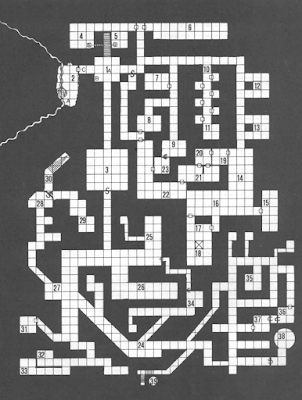Day 6 - A Module You Can Play with Children: DMG Monastery Dungeon by Gary Gygax

The Monastery Dungeon, 1979

Why I Love the Monastery Dungeon
- It's iconic design not only represents the one and only map in the Dungeon Masters Guide, but it is also central to the Example of Play
- Like all good dungeon designs, the monastery map is extensible, and built-in hooks help to coach a fledgling Dungeon Master how to further refine its contents:
- hints about additional monsters types from the Wandering Monster table: goblins in 7-8, bandits in 4-5, fire beetles in 12-13, ghouls from 24, evil cleric and hobgoblins from 35-37, skeletons from 27
- references from early keys to further ones yet-to-be-designed: the map's description in 2 mentions the secret door 28, the treasury at 29, and the caverns below this level; a secret entrance/exit is also mentioned in passing on page 96, in the description of the DMG's "three" maps (the other two sadly non-existent), and while not identified specifically, the stairs at 39 are suggestive of such a portal
- Despite being a pretty small dungeon (although it's still bigger than some levels of Rappan Athuk...), the map design offers a variety of challenges and tactical options for players (and monsters!) to leverage in play, including looping corridors, several secret and concealed doors, and a number of potentially-deadly dead-ends.
I have in fact followed-up on the suggestions to expand the monastery dungeon with my own second level caverns map, as well as modifications and expansion to the first level map, and the keying of both. More will follow on that front, later!
Three Runners Up
I'm limiting myself to three, otherwise I'll just end up recreating my favorites list each day:
- B1 In Search of the Unknown by Mike Carr (TSR, 1978): more forgiving that B2 or T1, the first level's design in particular does an excellent job of teaching new players how to play the game
- L1 The Secret of Bone Hill by Lenard Lakofka (TSR, 1981): an excellent bridging scenario that teaches new players the ropes of the first wilderness explorations (B10 Night's Dark Terror also does this well), and also details the Bone Hill ruined castle and dungeon, the town and inhabitants of Restenford, and outlying locations in the surrounding wilds
- "Trouble at Grog's" by Grant and David Boucher (TSR, March/April 1987 in Dungeon Magazine #4): a good introductory scenario for players with a more dramatic bent, perhaps: the PCs must solve the mystery of who's framing the local half-ogre tavern owner for a local crime spree
No comments:
Post a Comment
Please be respectful and civil in your commentary. Inappropriate comments may be edited or deleted as dictated by the whims of Balo, Chief Jester and Editor for the Lords of Chaos.